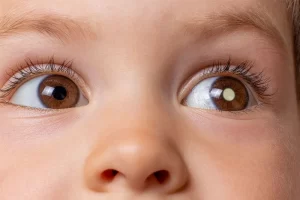What is retinoblastoma?
Recently, I came across 2 cases of retinoblastoma. It’s unusual to see 2 in one session, and a casual look at recent numbers in our centre revealed a steady increase in the number of this now not-so-rare childhood cancer. (see the image of the specimen below)
Retinoblastoma is a rare type of eye cancer that affects young children. It is the most common cancer of the eye in children, accounting for about 3% of all childhood cancers. In Kenya, available studies indicate that 1 in every 17,300 newborns get the disease.
With this brief article, I will dive into the causes, signs and symptoms, diagnosis, treatment, and prognosis of this disease.
Causes of retinoblastoma?
Retinoblastoma is caused by a genetic mutation (of the RB1 gene) that affects the development of the retina, the light-sensitive tissue at the back of the eye. In some cases, the mutation is inherited (run in families) from a parent, while in others, it occurs spontaneously (sporadic). This mutation can also increase the chances of getting other types of cancers as well.
Signs and Symptoms:
The most common sign of retinoblastoma is a white reflection in the pupil of the eye, which can be seen in flash photographs.

Other symptoms include:-
- Squint
- Change of colour of iris
- Poor Vision
It’s very easy to confuse white opacity with other eye diseases like cataracts or corneal ulcers, and this contributes to delays in diagnosis. Rarely retinoblastoma can involve both eyes.
Diagnosis of Retinoblatoma
Retinoblastoma can be diagnosed through a comprehensive eye exam, which may include imaging tests such as ultrasound,, or MRI. Histological diagnosis is usually performed after surgery.
Treatment options in retinoblastoma
The treatment of retinoblastoma depends on the size and location of the tumour, as well as the extent of the disease.
Treatment options include:
- chemotherapy,
- radiation therapy,
- laser therapy,
- cryotherapy, and
- surgery.
In some cases, the whole eye is removed (enucleation)
The outcome of Retinoblastoma:
The prognosis for retinoblastoma depends on the stage of the disease at the time of diagnosis. With early detection and treatment, the outlook is generally good, and most children are able to retain their vision. Sadly, most children in Kenya present too late to save vision. In a significant number of cases, the disease has spread to other parts, making cure impossible. In these advanced cases, the prognosis is quite poor.
Awareness and Advocacy
There is a need to create awareness of this disease in the community, early school and primary healthcare settings. Early diagnosis and treatment is the most critical factor in managing the menace of retinoblastoma. Further studies are needed to identify trends in the disease and inform effective interventions.
Disclaimer
The information provided on this medical blog is for general informational purposes only and should not be considered as a substitute for professional medical advice. Always consult with a qualified healthcare provider before making any healthcare decisions or taking any actions based on the information provided on this blog. The authors and publishers of this blog are not liable for any errors or omissions in the content or for any actions taken based on the information provided.
